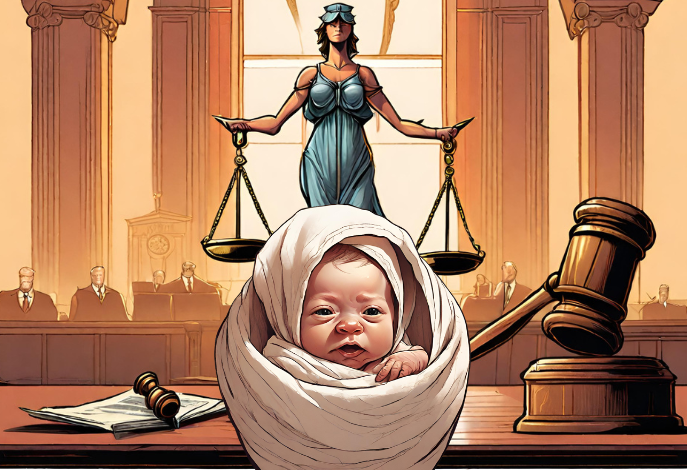The Legal Case for Abortion Abolition

For you formed my inward parts;
you knitted me together in my mother’s womb.
I praise you, for I am fearfully and wonderfully made.
Psalm 139:13–14
Preface
This article was originally a paper I wrote in law school. It was an extra credit assignment in my Family Law class, taught by a left-wing feminist professor. Thankfully, this professor was an old-school feminist who believed in free speech, and she gave me credit for the paper despite her violent disagreement with my opinion.
Because the article is written in “legalese,” it may seem too academic for a lay reader to understand what I’m saying. However, I ask that you give it a read anyway because for one, I am going to provide some definitions to make the task a little less challenging, and secondly, my dear Christian readers need to know that the Constitution as the Founding Fathers intended never supported, and will never support, the murder of innocent babies.
Definitions
- Due Process: The clause in the 14th amendment to the Constitution which states that “No State shall…deprive any person of life, liberty, or property, without due process of law.”
- Substantive Due Process: The belief that the Due Process clause of the 14th amendment to the Constitution implies new rights that the Supreme Court can create as society evolves.
- Equal Protection: The clause in 14th amendment to the Constitution which states that “No State shall…deny to any person within its jurisdiction the equal protection of the laws.”
- Jurisprudence: The history of caselaw that forms the current binding interpretation of laws based on judge’s decisions.
- Penumbra: the partially shaded outer region of the shadow cast by an opaque object.
- Emanation: an abstract but perceptible thing that issues or originates from a source.
Introduction
Ever since the United States Supreme Court handed down its seminal and controversial decision in Roe v. Wade1, debate has raged within the halls of academia. Central to the myriad issues Roe has raised is that of constitutional justification. On the one hand, pro-abortion scholars tend to utilize a positivist approach, viewing the constitution as a “living document” that can create new substantive rights that reflect modern ethical and philosophical trends, eventually leading to abortion becoming recognized as one of those rights.2 On the other hand, originalists view abortion as one of a long list of unenumerated rights that are not even remotely implied in the text of the constitution.3 The ultimate quest to resolve the issue of abortion in the courts has been further complicated in the Dobbs decision, overturning Roe and returning the issue of abortion back to the states.4 Notably, Justice Alito in Dobbs claimed that the Equal Protection justification for abortion is “squarely foreclosed by the Court’s precedents, which establish that a State’s regulation of abortion is not a sex-based classification …”5 After summarizing the Substantive Due Process (SDP) and Equal Protection (EP) justifications for upholding prior abortion jurisprudence, this essay will argue that, because the unborn is scientifically and legally considered a “person,” the unborn should be deemed a “person,” in the abortion context. Thus, the Equal Protection Clause of the Fourteenth Amendment should apply to the unborn.
Background
Substantive Due Process
Substantive Due Process (SDP) can be defined as the “constitutional guaranty that no person shall be arbitrarily deprived of his life, liberty, or property; the essence of this guaranty is protection from arbitrary and capricious action.”6 The doctrine finds its modern origin in Justice Harland’s dissenting opinion in Poe v. Ullman, in which he opines that, “…[T]he full scope of the liberty guaranteed by the Due Process Clause cannot be found in or limited by the precise terms of the specific guarantees elsewhere provided in the Constitution. It … includes a freedom from all substantial arbitrary impositions and purposeless restraints …”7 Justice Kennedy elucidated the philosophical underpinning of SDP by postulating that constitutional liberty confers “the right to define one’s own concept of existence, of meaning, of the universe, and of the mystery of human life.”8
While Harland laid the persuasive groundwork for future decisions, Justice Douglas codified SDP into binding law in Griswold v. Connecticut, holding that various rights within the Bill of Rights, such as the First Amendment’s protections of freedom of association and speech, and the Fourteenth Amendment’s protection of a parent choosing how to educate their children, among other rights “suggest that specific guarantees in the Bill of Rights have penumbras, formed by emanations from those guarantees that help give them life and substance. Various guarantees create zones of privacy.”9 Justice Douglas went on to explain that the zone of privacy emanating from the Bill of Rights includes the right to contraception.10
While the right to contraception was recognized within the SDP framework, abortion still had not reached the same status until the 1970s. In Eisenstadt v. Baird, confirming the woman’s SDP right to contraception, Justice Brennan foreshadowed Roe when he declared, “If the right of privacy means anything, it is the right of the individual … to be free from unwarranted governmental intrusion into matters so fundamentally affecting a person as the decision whether to bear or beget a child.”11 Indeed, Justice Blackmun amplified Brennan’s sentiment in Roe by affirming that “[t]his right of privacy … is broad enough to encompass a woman’s decision whether or not to terminate her pregnancy.”12
Since Roe and Casey, proponents of SDP argue from the perspective of female autonomy. For instance, constitutional scholar Erika Hansen epitomized this view: “…the core principles of autonomy, dignity, and equality strengthen all substantive due process rights, including the right to abortion … [The] harms inflicted upon women by abortion restrictions amount to a denial of equal liberty.”13 For Hansen, SDP is a way to ensure that constitutional liberty avoids subjugating women by recognizing the autonomy of the woman in her decision to have an abortion. However, some critics have argued that the Griswold line of cases stands on shaky constitutional ground, and that the woman’s right to abortion should instead rest in the Equal Protection Clause of the Fourteenth Amendment.
Equal Protection for Women
Harvard Law professor Cass R. Sunstein amplifies Blackmun’s view by expounding that the shorthand argument for abortion using Equal Protection (EP) “… sees a prohibition on abortion as invalid because it involves a cooptation of women’s bodies for the protection of fetuses … No parallel disability is imposed on men.”14 The EP grounding sees men and women on unequal footing due to women’s unique burden of carrying a fetus to term, thus necessitating a right to abortion to bring about equal protection. And while EP and SDP are the main legal battlegrounds for abortion, there is one argument that is not frequently part of the conversation, which deserves attention.
While the Supreme Court has been reluctant to utilize EP to recognize the right to abortion, and of recent Alito has been antagonistic to it, the idea is worth considering. There is a large body of scholarship on EP with respect to abortion access with many proponents. While EP has not been considered binding in any Supreme Court holdings on abortion, it has been cautiously mentioned in precedent. Justice Blackmun’s concurrence in Planned Parenthood v. Casey gives the clearest justification for EP with respect to abortion in the jurisprudence: “This assumption—that women can simply be forced to accept the ‘natural’ status and incidents of motherhood—appears to rest upon a conception of women’s role that has triggered the protection of the Equal Protection Clause.”15 In Blackmun’s view, if society were to force women to take on the burdens of motherhood, this would not be treating women equally under the law and would signify an EP violation.
- Equal Protection for Unborn Persons
While scholars debate the constitutionality of abortion access, they tend to presuppose the inhumanity of the unborn by fiat, without careful examination. However, there is a body of scholarship which argues that the unborn fetus should be considered a legal “person” under abortion law. As legal scholar Brendan F. Pons acknowledges, “… [Defining fetal personhood] is important because the question of when life begins determines basic constitutional guarantees. Therefore, applying personhood to the law is a basic constitutional question … [for determining] whether [the unborn] should have equal protection …”16
In this view, it is thought inconsistent that the unborn is treated as a person in other areas of the law, but not in abortion jurisprudence. For example, Chapman professor Rachel Warren gives myriad instances in which the law recognizes the personhood of the unborn: “After Roe held that a pre-viable unborn child is not a person under the Constitution, the opposite occurred in state criminal law. In refusing to take guidance from the Supreme Court’s viability standard for human recognition, twenty-four states have extended legal protection for the life of the unborn, regardless of the stage of pregnancy.”1718 In these states, if a criminal act causes death or injury of an unborn baby, the perpetrator is subject to criminal penalties. Given this reality, proponents of the pro-life and abolitionist EP view claim it is contradictory that an unborn fetus is considered a “person” in these states’ criminal codes but is not a “person” under abortion law. The next section will begin with a brief evaluation of the SDP and EP approaches to upholding abortion, and then will advocate for the merit of the EP approach to abolishing abortion.
Analysis
Firstly, the SDP approach’s constitutionality is tenuous at best, even to many pro-abortion scholars. As TerBeek admits, “substantive due process is surely, as conservatives charge, a vehicle for ‘discovering new rights’ as society changes.”19 Additionally, Justice Goldberg arguably concedes the unconstitutionality of SDP when he claims that the idea of “liberty” is expansive, and that the idea of marital privacy “is not mentioned explicitly in the Constitution.”20 If an idea is so attenuated from the Constitution that the Bill of Rights has to cast a “penumbra” for that idea to have any constitutional force, then that idea cannot possibly be considered constitutional without turning the Constitution into a hopelessly postmodern document, subject to any interpretation from judges who can cast penumbras to forward any legislation that cannot be passed through Congress.
Likewise, Justice Alito’s critique of the EP justification for abortion displays its constitutional weakness: “The regulation of a medical procedure that only one sex can undergo does not trigger heightened constitutional scrutiny unless the regulation is a ‘mere pretext[t] designed to effect an invidious discrimination’ … And as the Court has stated, the ‘goal of preventing abortion’ does not constitute ‘invidiously discriminatory animus’ against women.”21 Indeed, a substantial percentage of women are pro-life or abolitionist, showing that this issue is not one of animus against women.22 Furthermore, those who are pro-life and abolitionist generally focus their attention on preserving the life of the unborn, not on discriminating against women. Therefore, the EP argument for abortion lacks constitutional and evidentiary grounds. This analysis will now turn to an evaluation of the abolitionist EP argument.
To forward the EP case for banning abortion, one must first establish that the unborn is a “life” which constitutes a “human person” from the moment of conception.2324 As pro-abortion TerBeek concedes, “If … abortion kills a human person, [we] would be obligated to treat abortion criminally, in substantially the same way as murder.”25
Biologically, the fact of the personhood of the unborn is well-established. Brandeis Law professor Robert L. Stenger elucidates, “From the process of fertilization emerges unique human life, whose DNA is derived from that of both biological parents and whose DNA is unlike that of any other living thing. From fertilization there is life and it is human life; it is not potential life or potentially human life. Fertilization is the most critical event in the life of an organism because it effects the cell-to-organism transition that initiates a species-specific developmental trajectory.”26 From the beginning, the unborn person is alive, undergoes development, develops a heartbeat by the eighteenth day, develops brain cells within 14 days, and can even feel pain well within the first trimester.27 Thusly, the biological case for life at conception has already been made. In addition, as aforementioned, the legal recognition of the fetus as a person in criminal codes is well established. There exists no cogent reason why an unborn child is considered a “person” under criminal law, but not under abortion law.
Another question exists: when there are two competing interests between the mother’s bodily autonomy and the unborn person’s right to life, whose rights should take priority? Warren said it best, observing that, “… if the fetus is … a constitutional person, then any legislature that permits abortion is allowing others to deprive the unborn child of life … without equal protection … Normally, the child’s guardian would represent this right, but here this is the very person with the conflicting interest. Thus, it is necessary for the state to step in and protect the child’s rights.”28 For the foregoing reasons, the constitution should extend protection to the unborn, and abortion should be criminalized as murder.
- 410 U.S. 113 ↩︎
- In the Roe decision, Justice Blackmun noted the growing trend of states and courts recognizing the right to abortion to justify the decision: “Although the results are divided, most of these courts have agreed that the right of privacy, however based, is broad enough to cover the abortion decision …” Roe v. Wade, 410 U.S. 113, 155 (1973) ↩︎
- For example, Justice Rehnquist asserted in his dissent to Roe’s holding: “To reach its result, the Court necessarily has had to find within the Scope of the Fourteenth Amendment a right that was apparently completely unknown to the drafters of the Amendment.” 410 U.S.113 at 174 (1973) ↩︎
- Dobbs v. Jackson Women’s Health Org., 142 S.Ct. 2228 (June 24, 2022) ↩︎
- Id. at 2235 ↩︎
- Stevens v. St. Tammany Par. Govt., 322 So. 3d 1268 (La. App. 1st Cir. 2021) ↩︎
- Poe v. Ullman, 367 U.S. 542 (1961) ↩︎
- Planned Parenthood of S.E. Pennsylvania v. Casey, 505 U.S. 833, 851 (1992) ↩︎
- Griswold v. Connecticut, 381 U.S. 479, 484 (1965) ↩︎
- Id. at 485 ↩︎
- Eisenstadt v. Baird, 405 U.S. 438, 453 (1972) ↩︎
- Roe v. Wade, 410 U.S. 113, 153 (1973). ↩︎
- Erika Hanson, Lighting the Way Towards Liberty: The Right to Abortion After Obergefell and Whole Woman’s Health, 45 Hastings Const. L.Q. 93, 94, 105 (2017) ↩︎
- Planned Parenthood of S.E. Pennsylvania v. Casey, 505 U.S. 833, 928 (1992) ↩︎
- Cass R. Sunstein, Neutrality in Constitutional Law (with Special Reference to Pornography, Abortion, and Surrogacy), 92 Colum. L. Rev. 1, 31–32 (1992). ↩︎
- Brendan (Bo) F. Pons, The Law and Philosophy of Personhood: Where Should South Dakota Abortion Law Go from Here?, 58 S.D. L. Rev. 119, 120–21 (2013) ↩︎
- Rachel Warren, Pro (Whose?) Choice: How the Growing Recognition of A Fetus’ Right to Life Takes the Constitutionality Out of Roe, 13 Chapman L. Rev. 221, 237 (2009) ↩︎
- Additionally, the Unborn Victims of Violence Act of 2004 makes it a separate Federal crime to kill or substantially injure an unborn child. The Act importantly defines “a child in utero” as “a member of the species homo sapiens, at any stage of development, who is carried in the womb.” ↩︎
- Calvin TerBeek, Empiricizing the Equal Protection Approach to Abortion, 38 McGeorge L. Rev. 775, 791–92 (2007) ↩︎
- Griswold v. Connecticut, 381 U.S. 479, 486 (1965) ↩︎
- Dobbs v. Jackson Women’s Health Org., 213 L. Ed. 2d 545 (June 24, 2022) ↩︎
- A recent US poll finds that 39% of Americans identify as pro-life. A majority of Americans identify as ‘pro-choice,’ Gallup poll says : NPR ↩︎
- Merriam-Webster Defines “Life” as “An organismic state characterized by capacity for metabolism, growth, reaction to stimuli, and reproduction. Life Definition & Meaning — Merriam-Webster ↩︎
- Merriam-Webster Defines “Person” as a “Human individual.” And “human” is defined as “a bipedal primate mammal (Homo sapiens).” Person Definition & Meaning — Merriam-Webster; Human Definition & Meaning — Merriam-Webster ↩︎
- Calvin TerBeek, Empiricizing the Equal Protection Approach to Abortion, 38 McGeorge L. Rev. 775, 814 (2007) ↩︎
- Robert L. Stenger, Embryos, Fetuses, and Babies: Treated As Persons and Treated with Respect, 2 J. Health & Biomedical L. 33, 38 (2006) ↩︎
- Rachel Warren, Pro (Whose?) Choice: How the Growing Recognition of A Fetus’ Right to Life Takes the Constitutionality Out of Roe, 13 Chapman L. Rev. 221, 235 (2009) ↩︎
- Rachel Warren, Pro (Whose?) Choice: How the Growing Recognition of A Fetus’ Right to Life Takes the Constitutionality Out of Roe, 13 Chapman L. Rev. 221, 242, 245 (2009) ↩︎



